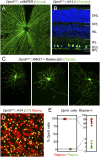Violet light suppresses lens-induced myopia via neuropsin (OPN5) in mice
- PMID: 34031241
- PMCID: PMC8179197
- DOI: 10.1073/pnas.2018840118
Violet light suppresses lens-induced myopia via neuropsin (OPN5) in mice
Abstract
Myopia has become a major public health concern, particularly across much of Asia. It has been shown in multiple studies that outdoor activity has a protective effect on myopia. Recent reports have shown that short-wavelength visible violet light is the component of sunlight that appears to play an important role in preventing myopia progression in mice, chicks, and humans. The mechanism underlying this effect has not been understood. Here, we show that violet light prevents lens defocus-induced myopia in mice. This violet light effect was dependent on both time of day and retinal expression of the violet light sensitive atypical opsin, neuropsin (OPN5). These findings identify Opn5-expressing retinal ganglion cells as crucial for emmetropization in mice and suggest a strategy for myopia prevention in humans.
Keywords: myopia; neuropsin (OPN5); nonvisual photoreceptors; violet light.
Copyright © 2021 the Author(s). Published by PNAS.
Conflict of interest statement
Competing interest statement: Related to myopia-preventing devices based on violet light illumination and transparency, H.T., T.K., and K.T. have been applying internationally for two patents, WO 2015/186723 and WO 2017/094886. The former has been registered in Japan, the United States, and China, and the latter in Japan, the United Kingdom, France, Germany, Italy, Hong Kong, and Singapore. There is a patent application for the design of the mouse eyeglass by Tsubota Laboratory, Inc. (patent application no. 2017-41349). K.T. reports his position as CEO of Tsubota Laboratory, Inc., Tokyo, Japan, a company producing myopia-related devices. R.L. has a sponsored research agreement with BIOS Lighting and, in collaboration with BIOS Lighting, has submitted patent application 41906194/PCT/US21/17681, Lighting Devices to Promote Circadian Health.
Figures




Comment in
-
Seeing the violet light.Lab Anim (NY). 2021 Jul;50(7):167. doi: 10.1038/s41684-021-00807-x. Lab Anim (NY). 2021. PMID: 34188232 No abstract available.
References
-
- Ikuno Y., Overview of the complications of high myopia. Retina 37, 2347–2351 (2017). - PubMed
-
- Ohno-Matsui K., Lai T. Y., Lai C. C., Cheung C. M., Updates of pathologic myopia. Prog. Retin. Eye Res. 52, 156–187 (2016). - PubMed
-
- Ohno-Matsui K., Pathologic myopia. Asia Pac. J. Ophthalmol. (Phila.) 5, 415–423 (2016). - PubMed
-
- Dolgin E., The myopia boom. Nature 519, 276–278 (2015). - PubMed
-
- Holden B. A., et al. ., Global prevalence of myopia and high myopia and temporal trends from 2000 through 2050. Ophthalmology 123, 1036–1042 (2016). - PubMed
Publication types
MeSH terms
Substances
Associated data
Grants and funding
LinkOut - more resources
Full Text Sources
Other Literature Sources

